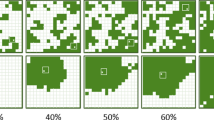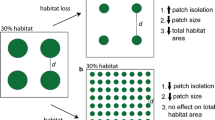Abstract
The practice of landscape ecology is generally one that attempts to understand how patterns of abundances may interact with the physiognomic and compositional characteristics of landscapes (Dunning et al. 1992, Morris and Brown 1992). However, the goal is to understand why populations, enumerated across large spatial scales, frequently are not equivalent to the sum of the productivities of the component patches of usable habitat across that same region. This discrepancy generally results from the underutilization of available resources (e.g., food, cover, or breeding habitats), which, in turn, may result from the species’ inability to find these resources in time to fully exploit them. In this way, fragmented landscapes are thought to pose difficult problems for the persistence of mammalian metapopulations (see Lidicker 1995, and chapters therein for review).
Access this chapter
Tax calculation will be finalised at checkout
Purchases are for personal use only
Preview
Unable to display preview. Download preview PDF.
Similar content being viewed by others
Literature Cited
Anderson, G.S. 1995. The influence of spatial factors on animal populations: a model and some empirical data. M.S. Thesis, Iowa State University, Ames, Iowa.
Bennett, A.F., K. Henein, and G. Merriam. 1994. Corridor use and the elements of corridor quality: chipmunks and fencerows in a farmland mosaic. Biological Conservation 68: 155–166.
Calder, W.A. III. 1984. Size, function, and life history. Harvard University Press, Cambridge, Massachusetts.
Dunning, J.B., B.J. Danielson, and H.R. Pulliam, 1992. Ecological processes that affect populations in complex landscapes. Oikos 65: 169–175.
Dunning, J.B., D.J. Stewart, B.J. Danielson, B.R. Noon, T.L. Root, R.H. Lamberson, and E.E. Stevens. 1995. Spatially explicit population models: current forms and future uses. Ecological Applications 5: 3–11.
Deutsch, C.V., and A.G. Journel. 1992. GSLIB geostatistical software library and user’s guide. Oxford University Press, New York, New York.
Fahrig, L., and G. Merriam. 1985. Habitat patch connectivity and population survival. Ecology 66: 1762–1768.
Golley, F.B. 1962. Mammals of Georgia. University of Georgia Press, Athens, Georgia. Golley, F.B., J.B. Gentry, L.D. Caldwell, and L.B. Davenport, J. 1965. Number and variety of small mammals on the AEC Savannah River Plant. Journal of Mammalogy 46: 1–18.
Kaiser, M.S., P.L. Speckman, and J.R. Jones. 1994. Statistical models for limiting nutrient relationships in inland waters. Journal of the American Statistical Association 89: 410–423.
Kelt, D.A., and D. Van Vuren. 1999. Energetic constraints and the relationship between body size and home range area in mammals. Ecology 80: 337–340.
LaPolla, V.N., and G.W. Barrett. 1993. Effects of corridor width and presence on population dynamics of the meadow vole (Microtus pennsylvanicus). Landscape Ecology 8: 25–37.
Lorenz, G.C., and G.W. Barrett. 1990. Influence of simulated landscape corridors on house mouse (Mus musculus) dispersal. American Midland Naturalist 123: 348–356.
Lidicker, W.Z., Jr. (editor). 1995. Landscape approaches in mammalian ecology and conservation. University of Minnesota Press, Minneapolis, Minnesota.
Morris, D.W. 1988. Habitat-dependent population regulation and community structure. Evolutionary Ecology 2: 253–269.
Morris, D.W., and J.S. Brown. 1992. The role of habitat selection in landscape ecology. Evolutionary Ecology 6: 357–359.
Pulliam, H.R. 1996. Sources and sinks: empirical evidence and population consequences. Pages 45–68 in Population dynamics in ecological space and time. O.E. Rhodes, R.K. Chesser, and M.H. Smith, editors. University of Chicago Press, Chicago, Illinois.
Scharf, F.S., F. Juanes, and M. Sutherland. 1998. Inferring ecological relationships from the edges of scatter diagrams: comparison of regression techniques. Ecology 79: 448–460.
Silva, M., and J.A. Downing. 1995. CRC handbook of mammalian body masses. CRC Press, Boca Raton, Florida.
Thomson, J.D., G. Weiblen, B.A., Thomson, S. Alfaro, and P. Legendre. 1996. Untangling multiple factors in spatial distributions: lilies, gophers, and rocks. Ecology 77: 1698–1715.
Wegner, J.F., and G. Merriam. 1979. Movement by birds and small mammals between a wood and adjoining farmland habitats. Conservation Biology 2: 349–357.
Wegner, J.F., and G. Merriam. 1990. Use of spatial elements in a farmland mosaic by a woodland rodent. Biological Conservation 54: 263–276.
Zhang, Z., and M.B. Usher. 1991. Dispersal of wood mice and bank voles in an agricultural landscape. Acta Theriologica 36: 239–245.
Editor information
Editors and Affiliations
Rights and permissions
Copyright information
© 1999 Springer Science+Business Media New York
About this chapter
Cite this chapter
Danielson, B.J., Anderson, G.S. (1999). Habitat Selection in Geographically Complex Landscapes. In: Barrett, G.W., Peles, J.D. (eds) Landscape Ecology of Small Mammals. Springer, New York, NY. https://doi.org/10.1007/978-0-387-21622-5_5
Download citation
DOI: https://doi.org/10.1007/978-0-387-21622-5_5
Publisher Name: Springer, New York, NY
Print ISBN: 978-1-4757-5640-1
Online ISBN: 978-0-387-21622-5
eBook Packages: Springer Book Archive




